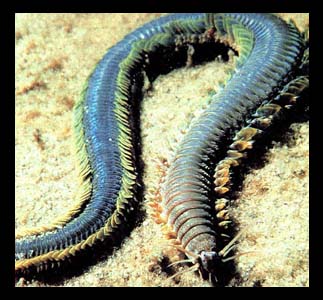Your run of the mill “bristleworm”. That’s right a “bristleworm”. All “bristleworms” are members of the Phylum Annelida, Class Polychaeta. Should you take it out? No way, most errant polychaetes (errant meaning that they move about freely searching for food) are beneficial scavengers and crucial members of the live sand community. Probably ninety-nine percent of the “bristleworms” are harmless and are reef-safe. These animals are active scavengers and predators, but most are strictly opportunistic. The predatory ones usually only consume other worms, detritus, bacteria, algae, micro-crustaceans and other things. This is a very positive and desirable activity. There are only a few notable exceptions to this rule that aquarists should be aware of, and even these exceptions are somewhat rare in aquaria. The primary exceptions are a few species of the Family Amphinomidae. One species in particular has become the stereotypical bad “bristleworm”, the Caribbean Hermodice carunculata, but is rare in aquaria (probably due to the small amount of Caribbean rock used in our tanks) and it’s diet is primarily gorgonians.



